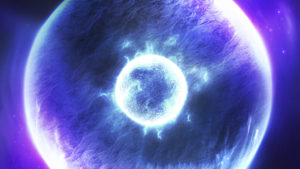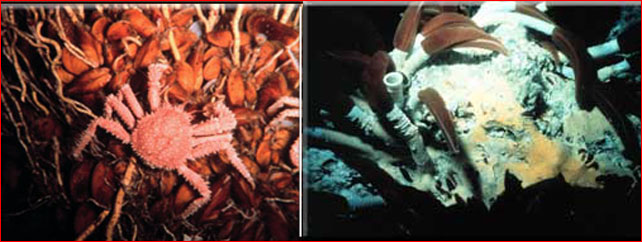


Life Outside the “Habitable Zone”
The mystery of life, how it arises and how it survives in extreme conditions, may open new windows to the world of plasma and electricity.
Human beings live on a planet where life thrives in every possible niche. Even at the frozen poles, life hangs on. We used to think that with too much or too little sunlight and without liquid water, life could not exist. Scientists developed the concept of a “habitable zone” around the sun—a range of orbits in which a planet would receive the right amount of energy from the sun to allow photosynthesis and to keep water liquid.
But then we discovered whole communities of organisms (images above) that thrive on the heat of underwater volcanoes. Bacteria synthesize chemicals in the hot water and live on the excess energy. Other life forms eat the bacteria. Tubeworms (image above) have no mouths or digestive systems. The chemosynthetic bacteria live inside the worms and transfer energy directly to the worms’ cells. The entire community exists without sunlight.
Still, as far as we can tell, life does require liquid water. Some organisms produce spores that can survive for centuries without water, but they need water to spring back to life. Others thrive in the near-boiling water of hot springs, but the water is still liquid. Nevertheless, the discovery of life that uses energy sources internal to the Earth undermines the concept of a habitable “zone”: Life could exist on a planet with a molten core or with tidal heating regardless of its distance from its sun.
The Electric Universe extends the possible locations for life even further. The behavior of plasma may provide another source of heat. Jupiter’s moons, for example, are awash in electrical activity. Scientists have already postulated that two of the moons, Europa and possibly Callisto, have liquid water oceans beneath their frozen surfaces because of tidal heating. The Galileo probe discovered “rains of electrons” falling onto these moons. Plasma cosmologists call such “rains” electric currents, and they know the currents must close in circuits. Those circuits must travel over or through the moons, and any resistance will convert some of the energy into heat. This raises the possibility that electricity could heat and melt subsurface water. The current coursing through Jupiter’s inner moon, Io, is even greater than that on Europa or Callisto, and it sports volcanoes that are hot and active. (See “Filamentation of Volcanic Plumes on the Jovian Satellite Io” here.) If water exists anywhere on Io, that may be another place to look for life.
Furthermore, the biological sciences have not considered the role plasma may play in the origin of life and its adaptation to sudden changes in environment. Just as astronomers are finding that plasma in space is important to cosmology, biologists may discover that it’s important to the origins and evolution of life as well.
Biological experiments that try to create life often make use of electrical discharge as well as chemical reactions. Were these experiments showing us that the electrical activity is a fundamental part of the life-forming process?
Catastrophic theory brings up another question. If plasma activity accompanied the catastrophic mass extinctions of Earth, then could this activity also stimulate surviving life to adapt to new conditions in a single generation? This would explain the puzzle that biologist Stephen Jay Gould noticed: The fossil record doesn’t show gradual changes in species. Instead, it shows new species appearing fully formed and then remaining unchanged for all of their existence. A plasma point of view would see this as a normal life function: the increased plasma activity of the catastrophic event would stimulate sudden and mutually responsivechanges both in living forms and in their environment.
And what does this say about the habitable zone? Perhaps we should be looking for life in places where there has been strong plasma activity. In addition to moons that orbit close to their active gas giants, Wallace Thornhill points out that this would include planets that orbit inside the chromospheric glow discharge of dim red stars. In fact, conditions inside such a star might be ideal for life, unaffected by seasons or day/night cycles.
Nobel Laureate Irving Langmuir chose the term “plasma” to describe the life-like behavior of electrified gases. That description works the other way around, too: Life has plasma-like behavior. Could this resemblance be more than analogy? Is plasma, like liquid water, an essential component of life? Do we need a new science of plasma biology?
EXECUTIVE EDITORS: David Talbott, Wallace Thornhill
MANAGING EDITOR: Amy Acheson
CONTRIBUTING EDITORS: Mel Acheson, Michael Armstrong, Dwardu Cardona,
Ev Cochrane, C.J. Ransom, Don Scott, Rens van der Sluijs, Ian Tresman
WEBMASTER: Michael Armstrong
Copyright 2005: thunderbolts.info